#Plywood Market Size
Explore tagged Tumblr posts
Text
The report “Plywood Market” is valuable to anyone who wants to understand the global Plywood industry. The study provides a comprehensive analysis on the market trends, prices, applications, regional breakup, manufacturers, imports, exports, manufacturing process.
#Plywood Market Size#Plywood Market Share#Plywood Market Trends#Plywood Market Growth#Plywood Market Forecast#Plywood Market Report
0 notes
Text
Don't miss out on business opportunities in Plywood Market Industry Download to our Report PDF Brochure & gain crucial industry insights that will help your business grow. Click on Link For PDF Download https://www.marketsandmarkets.com/pdfdownloadNew.asp?id=233250253&utm_source=linkedin-ks&utm_medium=social&utm_campaign=chksoct24
2 notes
·
View notes
Text
#global plywood market#plywood market#global plywood market share#global plywood market size#global plywood market report#plywood market by type#plywood market by grade#plywood market by application#plywood market by countries
1 note
·
View note
Text
Plywood Market size is forecast to reach US$61.3 billion by 2027 after growing at a CAGR of 5.2% during the forecast period 2022-2027.
0 notes
Text
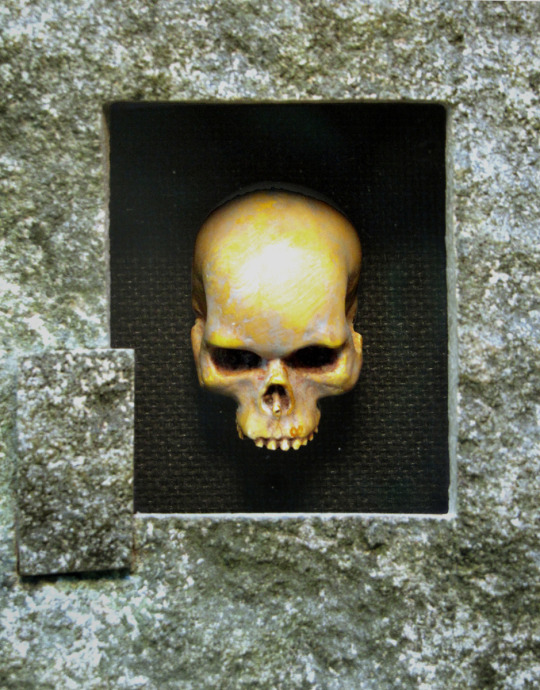



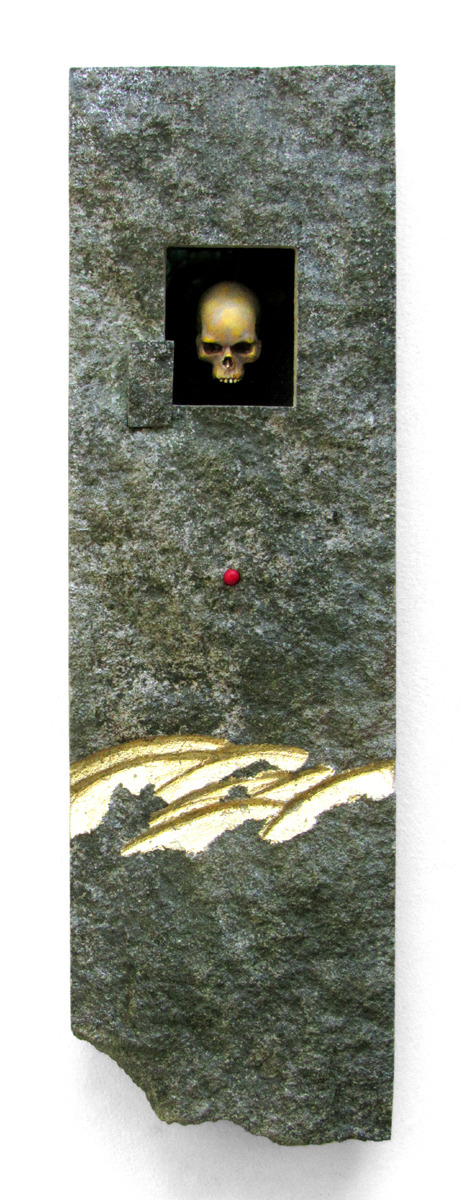
INTIMATIONS OF MORTALITY II
Indiana limestone, clear and colored glass, resin casting, imitation gold leaf, black linen matboard, plywood backer - 15¼"x 4⅝"x 1¾"
The work was originally done for an exhibit exploring what artists did while working during the COVID19 lockdown (POSTCARDS FROM THE WINDOW-2021 see link below). However, that work was stolen from the exhibit. I never had a work stolen from me before — it is a strange feeling knowing that my work so moved someone to the extent that they felt they had to have it while at the same time there is the dis-respect of having something taken away from me so I could never share it again. It was like they had stolen the words from my mouth while at the same time complementing me on my phrasing.
The piece had begun with a little found object token (a key fob in the form of a human skull) which I had separated from the chain and which had sat on my successive desktop computers for perhaps twenty years as a sort-of mascot. During the COVID lockdown I found myself focusing on this memento mori again and again, and finally decided to use it as part of a self-portrait as a survivor (for the time being, anyway).
After the work was stolen I felt like I had to replace it, to repeat the story someone took away from me, re-state my stolen 'words'. I tried to find a replacement skull to no avail — whoever had manufactured the key fobs originally all those years ago were not still marketing them that I could find, so I had to find or make another skull. I carved a skull in ebony but it wasn't right. I found a little plastic skeleton (anatomically correct, partially articulated), but it wasn't quite right either. I molded the skull but cut-off the lower jaw from the casting to make it more like the key-fob skull. Though it still was not perfect I felt this one would work.
So this piece is a re-made version of the stolen work with a slightly larger size skull and naturally different piece of limestone. The skull sans jawbone (i.e. - 'muted') is mounted under glass in a black linen shadowbox cut into the limestone. The naturally cleft surface of the limestone is covered in a natural aged algae patina to echo the age of times past. The fitted blood-red dot of glass and the energetic golden grinder cuts to suggest the idea of 'the quick and the dead'.
There is an exhibit (DAY OF THE DEAD) later this year I'll submit the work to so I can share my 'selfie' again.
see the post of three years ago after the theft:
www.fromthedust.tumblr.com/post/657719920161964033/signage-for-exhibit-postcards-from-the-window
17 notes
·
View notes
Text
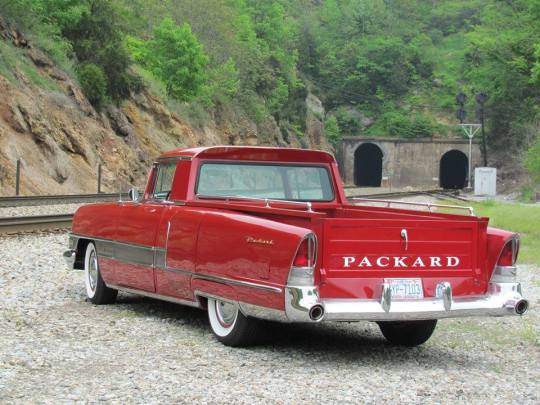
Packard Patricia pickup
Chris Coleman
Former Test Driver & Mechanic at Automotive Industry (2007–2008
What were the original reasons for Chevrolet coming out with the El Camino?
The El Camino, and other similar vehicles, like the Ford Ranchero, Subaru BRAT, Dodge Rampage and others, were designed to offer car-like comfort, performance and convenience, with the cargo capability of a light truck. Three of the forerunners to this were the Packard Patrician pickup, the Chevrolet Cameo and the Dodge Sweptline pickups.

1957 Dodge Sweptline with tailfins

Chevrolet Cameo Fleetside
The El Camino was based on the full-sized Impala originally, and was enormous. The low ground clearance and hefty weight made it a poor choice as a pickup. Most owners purchased them for styling reasons, especially with the cat eye taillights and horizontal tail fins.

1959 Chevrolet El Camino
Later, Chevrolet downsized the El Camino and based it on the Chevelle/Malibu, where it remained until it was discontinued.

1968 El Camino SS
With nothing in the rear, other than an empty bed, it was difficult to make it competitive as a muscle car, since the weight distribution was heavily biased towards the front.
Also, the bed used curved sheet metal in many places, to accommodate the rounded body panels, and this wasn’t a good fit with common pickup cargo, like plywood, hay bales and crates.
With the passenger compartment realistically holding two people, it was worthless as a family car, while a station wagon version of the Chevelle would be perfect. These things made it an odd fit with a very limited customer base.
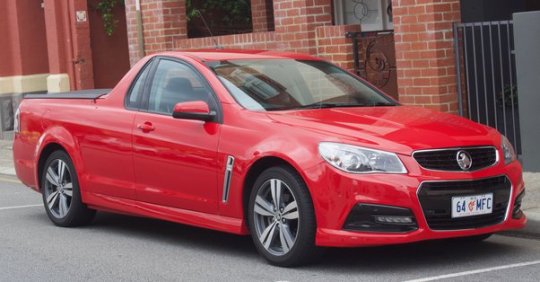
Holden Ute, from Australia
Paradoxically, in Australia, cars like these, called Utes (short for utility) were and are extremely popular. Australia has a more rural environment and remote ranches and homes, which make this type of vehicle perfect for them. However in a more suburban setting, like the U.S., the El Camino was always an odd choice.

1972 Ford Ranchero - Based on the Torino

Dodge Rampage
Dodge Rampage, built on the K-car platform

Subaru Baja
Today, no one makes a ute for the American market, but that doesn’t mean these may not resurface from time to time. As kids grow up and nests are emptied, we may once again see a demand for the ubiquitous El Camino, Ford Ranchero and others.
17 notes
·
View notes
Text
Co-op with Coop
On April 1st, I had a visit with the benefactor of my longest friendship Mark Cooper or “Coop” as I called him back in the day. It was April Fools, but this is not a prank and the only fool was me for not snapping a picture to mark the occasion. Coop and I met sometime around 1979 on the neighborhood streets of what was then called Lakeview Heights. Growing up in the late 70s and early 80s was one of those amazing times that, looking back on it, I feel so fortunate to have been a part of. Our upbringing in those days has become solidified in modern pop culture by way of memes, pictures and stories from those who survived that time. Depictions of kids jumping their BMX bikes over a rickety, hand-made ramp while 6 or 7 hapless friends lay prone beside the warped, plywood slope-- like decommissioned school busses in an Evil Knievel motorcycle stunt-- resonate with our generation on a deep level. How about the memories of what water tasted like coming out of a garden hose and the reminder to let the water run for a good 30 seconds on a hot day or else you got a mouthful of 90 degree plastic hose-flavored H2O? Mark lived one street over from me in those days and the shenanigans we found ourselves in never ended. We honestly didn’t stop from sun up to sun down (except for the occasional dinner bell or call of nature). All the kids in the neighborhood had each other’s phone numbers memorized back then there were no smartphone contact pages. The prefix was all the same and Mark’s # and mine were only 14 numbers apart. His number ended in 5-7-1-1 and mine in 5-7-2-5 and it wasn’t uncommon in those days to know your best friend’s number better than your own. From street hockey matches with anyone that walked by and wanted to join mid-game, to playing tag and kick-the-can in each other’s yards, knocking the pickets out of our fences when we used them as make-shift soccer nets, to pranking unsuspecting families with nicky nicky nine doors and running onto the road and mooning oncoming cars -- there was never a lack of crazy things for a bunch of 6-10 year olds to do back in those days. We would ride our bikes everywhere we could and usually that was to the local corner store, Grant’s Market, or a little further down the road to the laundromat or video store. Westside Video Classics was THE place to rent all the latest movies and games back in the day.
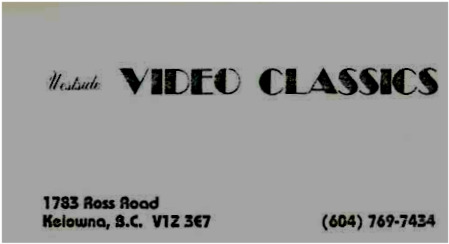
If it wasn’t movies or wrestling, Coop and I bonded over hockey cards (playing scramble, knock-downs and closeys), making comedy tapes on our cassette recorders (we thought we were a regular Bob & Doug McKenzie duo) and later on playing video games. At my house I introduced him to the two full-sized arcade machines my dad had bought from a co-worker and put in our rumpus room as he liked to call it: Super Soccer and Wild Cycle and then later games like Raid on Isram and Cosmic Cruncher on the Commodore Vic-20.

At his house we played endless rounds of Ring King and Super Mario Bros. 2 on his NES as well as countless hours of board games like Crokinole, Rummoli and Crossbows & Catapults. We had the definitive 80s childhood: trick-or-treating together in our shared neighborhood for years at Halloween time, sleepovers almost every other weekend, birthday parties and endless summer nights of hi-jinx. We shared in common younger siblings that tried to do everything we did at that time and rivalries with our respective kin that gave us even more to relate to. Sometime in the early 80s, Coop tattooed the drywall on his bedroom wall, in permanent marker no less, with the inscription: Best Friend Bobby since 1980. An homage to a friendship that, at that time, was a few years on but looking back now has been a friendship that has endured nearly 45 years. To take a page out of his playbook, I mocked my 7up sign to display the following:
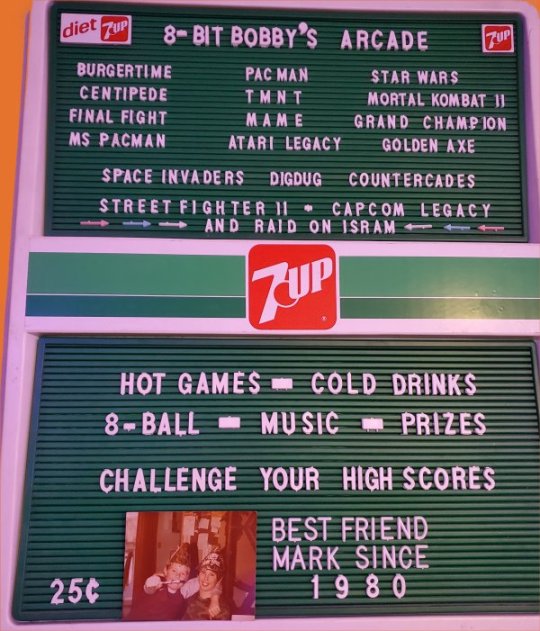
I am getting away from my story. All of this to say that Mark came by to meet the family and check out my game room, but became quickly overwhelmed with it all. He was audibly giggling from the moment I greeted him at the front door to the moment we made our way down to the ‘Arcade’ and then back up to the kitchen to sit and catch up. His energy was infectious and I knew that we would likely not be doing a lot of gaming on this visit but rather getting reacquainted and spinning shared experiences from those good old neighborhood days.
Fast forward a week and we got together again and this time we ended up spending a good hour re-living some of those nostalgic times down @ 8bit Bobby’s. Coop’s one pre-visit request was that he wanted to play some Raid on Isram. To make this possible, I had to hunt through various backups to find my rom files for the Vic-20 and then figure out how to interface it with my current Hyperspin setup on my M.A.M.E. Arcade machine. After some tweaking I managed to get it setup and somewhat playable. The game itself is nothing earth shattering and is essentially a watered-down clone of the popular game Scramble, but, to a couple of 40 somethings reliving the times when they were likely in the 10 and under category, it was pretty neat to play again. The object of the game is literally survival. You shoot a laser cannon and drop bombs on enemy ground-to-air missiles and fuel refineries. It starts out scrolling left to right in a pretty wide open playfield but as the game wears on the air-to-ground missiles begin taking off and you begin to enter narrow tunnels with what can only be described as flying spiders coming at you. You can shoot off the stalactites that make the caves a tight squeeze but if you are too busy contending with them you are sure to get hit by the unpredictable and weird trajectory of these squiggle-like arachnid creatures. Raid on Isram is a “one and done” game meaning you have one life to get as far as you can and then that’s it. No extra lives, no continues, nothing. THIS was the epitome of gaming back in the days before infinite lives, cheat codes and save states were a thing.

From here we moved on to some co-op games starting with Golden Axe. We got swiftly through the first two stages cracking heads and laying the boots to the little magic-stealing gnomes that appear between checkpoints only to have the game freeze without warning. I have played through several of these games and never had this happen before. It was a definite headscratcher but we were undeterred. We continued our co-operative game play with the Midway classic, Rampage. Just like back in the old days when we used to stomp around the neighborhood, we joined forces to destroy buildings, smash tanks and defeat digitized army men as George and Ralph the giant, Kong-like Ape and Wolfman respectively. We played through 19 “days” or cities and after each one we wondered how long the game went on for. After a quick Wikipedia search it would appear that the game has 128 days that, when completed, repeat 5 more times. It was good to know that this was a game we were not likely to finish in one sitting. Maybe a future stream event or something? Pictured below are our two protagonists: Coop & Bobby and in true fashion I am showing my age and lack of tech savviness by being unsure as to where I am supposed to be looking at the camera. I suppose a goofy picture is better than no picture at all.

This game room of mine and friends like Coop remind me how much of a role nostalgia plays in my life. The way certain sights or sounds can just transport a person back in time. I know we are not the same kids who hid in the willow trees on the neighbor’s property, cut through a field and hopped a fence into each others’ backyards with the ease and agility of an Olympic vaulter, and had water balloon fights while eating home-made popsicles to beat the summer heat, but for the hour or so that we connected tonight, we were transported back to a much simpler time. I leave you with the meme pasted below (which came up in conversation during his visit and I think really hits in the gut). Even though we can’t go back to that moment and give it the recognition and closure it deserved we can at least reminisce about what it was like just hanging out and teaming up against whatever was out there. Co-op with Coop 4 EVA.

#nostalgia#retro#80s#childhood#bmx#games#boardgames#arcade#friends#1980s#videogames#gamersunite#flashback#throwback#memes
9 notes
·
View notes
Text
Plywood Flooring: A Durable and cost-Effective Option for Bangalore Homes
Introduction
When it comes to flooring options for homes in Bangalore, plywood flooring has emerged as a popular choice among homeowners. Plywood flooring offers a combination of durability, cost-effectiveness, and aesthetic appeal, making it a suitable option for both traditional and modern homes. In this article, we will explore the various aspects of plywood flooring and delve into why it is an excellent choice for Bangalore homes.
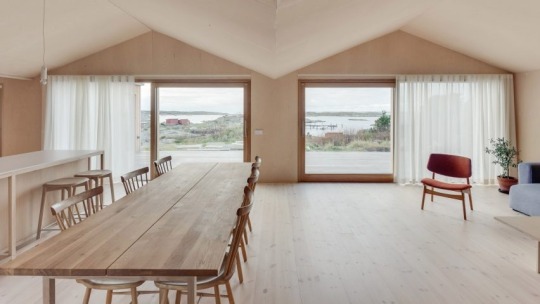
Visit Uro Veneer World and Buy your Plywood Collections for your House Decor.
Contact us for more information!!!!
Plywood Flooring: What Makes It an Ideal Choice?
Plywood flooring has gained immense popularity in recent years due to its numerous advantages. Let's take a closer look at why it is considered an ideal choice for homeowners in Bangalore.
1. Durability: The Foundation of Long-lasting Floors
One of the primary reasons plywood flooring is preferred by many homeowners is its exceptional durability. Plywood is made by layering thin sheets of wood together and bonding them with high-strength adhesives. This construction method results in a strong and stable material that can withstand heavy foot traffic, making it suitable for homes with children and pets.
2. Cost-Effectiveness: A Budget-Friendly Option
Bangalore homeowners are often on the lookout for cost-effective flooring solutions without compromising on quality. Plywood flooring fits the bill perfectly. Compared to other flooring options like hardwood or marble, plywood flooring is significantly more affordable while offering comparable durability and visual appeal. It provides an excellent balance between cost and quality, making it an attractive choice for budget-conscious individuals.
3. Versatility: Aesthetically Pleasing Designs
Plywood flooring offers homeowners the freedom to explore various design options and styles. Whether you prefer a rustic look or a contemporary feel, plywood can be stained, painted, or finished to achieve the desired aesthetic. It can seamlessly blend with different interior themes, allowing you to create a personalized space that reflects your unique style and taste.
4. Easy Installation: Saving Time and Effort
One of the advantages of plywood flooring is its relatively simple installation process. Plywood sheets are available in standard sizes and can be easily cut to fit any room. They can be installed over existing subfloor or concrete slabs, eliminating the need for extensive floor preparation. This makes the installation process faster and more convenient, saving both time and effort.
5. Environmental Sustainability: A Responsible Choice
In today's world, environmental sustainability is a crucial consideration for many homeowners. Plywood flooring is an eco-friendly option as it is made from renewable and sustainable wood sources. By choosing plywood flooring, you contribute to the conservation of forests and reduce your carbon footprint. Additionally, plywood can be recycled, further minimizing its impact on the environment.

Contact us for more information!!!!
Visit Uro Veneer World in Bangalore and Buy your favorite Laminate Collections for your House Decor.
Plywood Flooring vs. Other Flooring Options
To fully understand the benefits of plywood flooring, it is essential to compare it with other popular flooring options available in the market. Let's explore how plywood flooring fares against hardwood flooring, laminate flooring, and tiles.
Plywood Flooring vs. Hardwood Flooring: The Battle of Aesthetics
While both plywood and hardwood flooring offer a natural and elegant look, there are some significant differences to consider. Plywood flooring provides similar aesthetics to hardwood but at a fraction of the cost. Additionally, plywood is more resistant to moisture and temperature changes, making it suitable for areas prone to high humidity, such as kitchens and bathrooms. Hardwood flooring, on the other hand, requires more maintenance and may be prone to warping or shrinking in moisture-rich environments.
Plywood Flooring vs. Laminate Flooring: Balancing Cost and Durability
Laminate flooring has gained popularity due to its affordability and resemblance to natural wood. However, when compared to plywood flooring, it falls short in terms of durability. Plywood is more resistant to scratches, dents, and moisture, making it a better choice for areas with heavy foot traffic. Additionally, plywood can be sanded and refinished multiple times, allowing you to restore its original appearance. Laminate flooring, on the other hand, cannot be refinished and may need replacement after a certain period.
Plywood Flooring vs. Tiles: A Battle of Practicality
Tiles have long been a popular choice for homeowners due to their durability and ease of maintenance. However, plywood flooring offers several advantages over tiles. Plywood provides a warmer and more comfortable surface to walk on, especially during the colder months. It also offers better sound insulation, reducing noise transmission between floors. Moreover, plywood is less prone to cracking or chipping compared to tiles, making it a more practical choice for households with active lifestyles.
Contact Uro Veneer World in Bangalore for more information!!!!

FAQs (Frequently Asked Questions)
Q1: Is plywood flooring suitable for areas with high foot traffic?
Yes, plywood flooring is highly durable and can handle areas with high foot traffic without significant wear and tear.
Q2: Can plywood flooring be installed over existing flooring?
Yes, plywood flooring can be installed over existing flooring, such as concrete or vinyl, as long as the surface is clean, dry, and level.
Q3: Does plywood flooring require special maintenance?
Plywood flooring is relatively low maintenance. Regular sweeping and occasional mopping with a mild cleaning solution are usually sufficient to keep it clean.
Contact Uro Veneer World in Bangalore for more information!!!!
Q4: Can plywood flooring be refinished?
Yes, plywood flooring can be refinished. However, the number of times it can be refinished depends on the thickness of the top veneer layer.
Q5: Is plywood flooring resistant to termites?
While plywood is generally resistant to termites, it is still important to take preventive measures, such as proper sealing and regular inspections, to protect against termite infestations.
Q6: Can plywood flooring be used in areas with high moisture?
Plywood flooring can be used in areas with high moisture, such as bathrooms and kitchens, as long as it is properly sealed to protect against water damage.
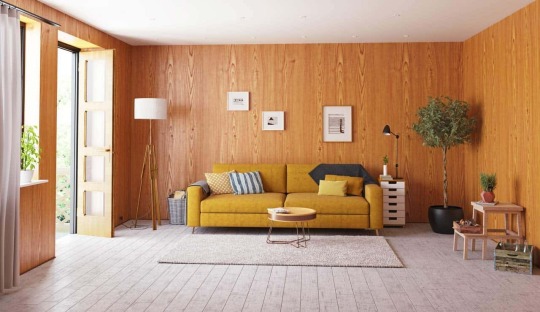
Conclusion
Plywood flooring has proven to be a durable, cost-effective, and aesthetically pleasing option for Bangalore homes. Its unique combination of advantages, including durability, affordability, versatility, and environmental sustainability, make it an excellent choice for homeowners looking to enhance their living spaces. Whether you're renovating your existing home or constructing a new one, consider plywood flooring as a viable option that offers long-lasting beauty and functionality.
Contact us for more information!!!!
Visit Uro Veneer World and Buy your favorite Laminate Collections for your House Decor.
#home improvement#interior design#plywood flooring#plywood sheets#plywood manufacturers#plywood price in bangalore#plywoods#laminates for kitchen cabinets#plywood#interior decorating#uro veneer world#living room#decor#interiordesign#interior#interiors#luxury house
2 notes
·
View notes
Text
The Technology behind Modern Furniture Designs
These days, technological advancement is seen influencing our lives, adding cutting-edge technologies, brand-new ideas & lasting materials to everything from mobiles to modern furniture that we use daily. It has resulted in more comfortable, durable & safer modern office furniture & made our lives full of luxury.
It is no secret that modern furniture has a great demand in the international market & a growing number of people choose it to give their homes or offices a contemporary look. However, some people are of the view that modern office furniture lacks new technology & ideas & appears more like the conventional ones. This is not found to be true.
To their surprise, more & more furniture manufacturers are using cutting-edge technologies & special materials to produce revolutionary, sustainable & portable modern furniture in attractive shapes & sizes. Most of these furniture makers maintain their own websites. So, people who want to go for remodeling in their home or office can start searching for them on the web.
A few decades back, we don't have enough options for modern furniture except a few common types of dining rooms, bedrooms & wall units. The technological advancement in modern furniture design has now given us the freedom to choose from hundreds of contemporary modern office furniture in different looks, materials & sizes so as to make our offices look more beautiful.
In earlier times, wood was highly used in the making of all kinds of furniture. Therefore the traditional furniture was too heavy, dull looking & was susceptible to water, light & other weather conditions. In an effort to increase the acceptability of conventional furniture, researchers introduced new furniture materials like plywood, and plastic etch. The furniture makers have started using these materials in furniture making & made the modern furniture light in weight & lovely in look. Even today, some of the furniture models are made of wood with plywood on the sides. This makes the furniture cost & weigh less & look classic. The furniture designers often make experiments with the furniture supplies including materials, using a combination of glass, wood, chrome & steel in the furniture-making process. Many are aware of the deteriorating global condition & want to use eco-friendly furniture designs. That's why the furniture for gardens & terraces is made from recycled materials. This is not all as the furniture makers are largely using a mixed variety of materials to produce more reliable & durable products. Now, heavy plasma TVs can be kept on fortified glass-made wall hangings.
Modern home & office furniture needs a fashionable look to draw the attention of more buyers. That's why the furniture makers keep on working with different colors, styles, patterns & shapes to bring an improvement in its value & functionality. Such transforming & sustaining furniture assures to give comfort to normal buyers who don't live in plush bungalows or apartments. It is a sophisticated technology that helps convert your comfy sofa into a perfect bed. Due to this technology, you can now purchase a convertible & smart-looking dining table with multiple moves to accommodate your whole family & friends whenever the necessity arises. Have you ever seen a modern armchair that can get transformed into a nice-looking lounge with just a button press? This is all the result of technological advancement in furniture making & designing.
Get the latest updates on modern office furniture, Meeting Tables, office chairs, office desks, Office Workstations, Office Sofas, Filling Cabinets, and Reception Desks in Dubai, for detailed office furniture, please visit our website officemaster.ae
Office Furniture Abu Dhabi, Office Furniture Sharjah, Office Furniture Doha – Qatar, Office Furniture Kuwait, Office Furniture Riyadh, Office Furniture Oman
OfficeMaster Al Quoz Branch – Office Furniture Dubai, Office Fit-out Dubai, Commercial Fit out Dubai, Residential Fit-out Dubai
No. 3, 34, 6 St., Dubai - UAE
+971 (0)50 651 9769
+971 (0)4 33 66 360

#office furniture#modern armchair#modern office furniture#Meeting Tables#office chairs#office desks#Office Workstations#Office Sofas#Filling Cabinets#Reception Desks#Office Furniture Abu Dhabi#Office Furniture Sharjah#Office Furniture Doha – Qatar#Office Furniture Kuwait#Office Furniture Riyadh#Office Furniture Oman#Office Furniture Dubai#Office Fit-out Dubai#Commercial Fit out Dubai#Residential Fit-out Dubai#modern furniture#furniture design#technology in furniture#furniture manufacturing#modern design#contemporary furniture#cutting-edge technology#innovative furniture#smart furniture#furniture engineering
2 notes
·
View notes
Text
Affordable Luxury Understanding Modular Kitchen Costs in 2025

In the world of home design, modular kitchens have emerged as a symbol of elegance and functionality. They seamlessly blend style with practicality, making them a popular choice among homeowners looking to elevate their culinary space. As we step into 2025, the concept of affordable luxury is more relevant than ever. With innovations in materials and design techniques, creating your dream kitchen doesn’t have to break the bank. Whether you’re eyeing high-end modular kitchen designs or seeking budget-friendly options that don’t skimp on quality, understanding the costs involved is crucial. This guide will help you navigate through everything from essential factors influencing pricing to tips for achieving that luxurious look without overspending. Dive in and discover how you can make your kitchen both stunning and functional while staying within your budget!
Benefits of Choosing a Modular Kitchen
Modular kitchens bring a blend of style and functionality to any home. They offer flexibility in design, allowing homeowners to customize layouts according to their unique space and lifestyle needs. The efficient use of space is another major advantage. With smart organization options like pull-out cabinets and corner solutions, these kitchens maximize storage without compromising on aesthetics. Quality materials often characterize modular designs. From high-grade plywood to durable laminates, you can choose finishes that suit your taste while ensuring longevity. Easy installation is also key. Unlike traditional setups that require extensive renovations, top modular kitchen design, units come pre-fabricated for quicker assembly. This means minimal disruption during the process. Modular kitchens are highly scalable. Whether you’re working with a small apartment or a grand estate, they adapt easily to various sizes and styles—making them accessible for everyone seeking affordable luxury at home.
Factors Affecting the Cost of a Modular Kitchen
When considering a modular kitchen, various factors play a crucial role in determining the overall cost. First and foremost, the materials used significantly influence pricing. From plywood to medium-density fiberboard (MDF), the choice of substance affects both durability and aesthetics. High-end materials often come with a heftier price tag. Next, customization can add to your expenses. Tailored designs that cater specifically to your preferences might require specialized craftsmanship, resulting in higher labor costs. The layout is another key factor; intricate configurations may demand more installation time and effort, impacting final bills. Additionally, brand reputation matters. Some of the top 10 modular kitchen companies in kolkata companies in India offer premium services but at elevated prices due to their established trustworthiness. Location influences costs as well. Urban areas like Kolkata or Pune might have different pricing dynamics based on local market trends and competition among suppliers.
Understanding the Different Components and their Costs
When diving into the world of modular kitchens, it’s essential to grasp the various components that contribute to both functionality and aesthetics. Cabinets often take center stage in any kitchen design. They can range from sleek laminate finishes to high-end solid wood options, impacting overall costs significantly. Countertops are another critical element. Choices like granite or quartz elevate luxury but come with a price tag, while materials like laminate provide affordability without sacrificing style. Don’t overlook hardware such as handles and hinges. top 10 modular kitchen brands, These small details can add personality and sophistication; investing in quality pieces is worthwhile. Additionally, innovative storage solutions—think pull-out shelves and spice racks—can enhance usability but will vary in cost depending on design complexity. Lighting fixtures also play a crucial role in creating ambiance. Choosing energy-efficient LED lights can save money long-term while offering modern appeal.
Tips for Designing an Affordable yet Luxurious Modular Kitchen
Start with a solid plan. Sketch out your desired layout, keeping efficiency and flow in mind. Prioritize functionality while ensuring it feels spacious. Choose materials wisely. Opt for high-end finishes like laminate or engineered wood that mimic luxury at a fraction of the cost. These options can provide durability without breaking the bank. Focus on smart storage solutions. Incorporate pull-out cabinets and hidden compartments to maximize space while maintaining an elegant appearance. top 10 modular kitchen companies in pune, Select statement pieces carefully. Invest in one or two standout items, such as an eye-catching backsplash or stylish lighting fixtures, to add visual impact without overpowering your budget. Don’t overlook color schemes either. Light colors can create an illusion of spaciousness, making even smaller kitchens feel luxurious and airy. Consider sustainable options. Eco-friendly materials not only enhance aesthetics but also reflect modern trends toward conscious living—adding value to your kitchen design.
The Future of Modular Kitchens: Advancements and Cost Predictions
The future of modular kitchens is poised for remarkable transformations. Innovative technologies are reshaping how we design and interact with these spaces. Smart appliances that integrate seamlessly into kitchen layouts will become commonplace, enhancing functionality and convenience. Sustainable materials are also gaining traction. Homeowners increasingly seek eco-friendly options without sacrificing style or durability. This trend could lead to a wider range of high-quality, sustainable choices at various price points. As demand grows, competitive pricing will likely emerge among top 10 modular kitchen companies in india with price list . This competition may bring luxury designs within reach for more consumers, making high-end options more accessible than ever before. Additionally, customization is set to rise as manufacturers invest in user-friendly platforms that allow homeowners to create their dream kitchens effortlessly. The merging of aesthetics with advanced technology will revolutionize the concept of affordable luxury in modern homes.
The Evolution of Kitchen Design
Kitchen design has come a long way from the utilitarian spaces of the past. Once seen merely as a place to cook, kitchens are now the heart of homes—a gathering spot for family and friends. In earlier times, kitchens featured heavy wooden furniture and dim lighting. Functionality was prioritized over aesthetics. However, with changing lifestyles came new trends that embraced openness and style. The introduction of modular kitchens revolutionized this space. Designed for efficiency, these setups maximize storage while offering sleek appearances. Today’s designs blend technology seamlessly with comfort. Open-concept layouts encourage social interaction, which modular kitchen is best, allowing cooks to engage with guests effortlessly. Materials have evolved too; eco-friendly options have become popular alongside luxury finishes like granite and quartz. As tastes change, so does kitchen design—always adapting to our needs while enhancing our living experiences in every meal prepared and shared within its walls.
What is a Modular Kitchen?
A modular kitchen is a contemporary approach to kitchen design, emphasizing efficiency and aesthetics. It consists of pre-fabricated units or modules that can be easily assembled to fit any space. These kitchens are tailored to individual needs, offering flexibility in layout and style. This adaptability makes them ideal for both small apartments and spacious homes. Each module typically includes cabinets, countertops, and storage solutions that complement each other seamlessly. The variety of materials available enhances customization options as well. What sets modular kitchen cheap and best, apart is their ability to combine practicality with luxury. Homeowners can choose from an array of designs—from sleek modern styles to more traditional looks—ensuring there’s something for everyone. Additionally, the ease of installation reduces time without compromising quality. With ongoing innovations in design and functionality, modular kitchens continue to redefine culinary spaces across the world.
Factors that Affect Modular Kitchen Costs
Several elements influence the costs of a modular kitchen. First, materials play a crucial role. High-quality wood or durable laminate can significantly affect pricing. Design complexity is another factor. Intricate layouts and custom features typically demand higher investment than standard designs. Next, appliances must be considered. Premium brands can elevate your budget quickly, while more affordable options provide value without sacrificing functionality. Labor costs vary by location and expertise level of professionals involved in installation. Skilled craftsmen may charge more but often ensure superior results. modular kitchen cabinet design, The size of your kitchen impacts overall expenses too. Larger spaces require more materials and labor, naturally increasing total costs. By understanding these factors, you can make informed decisions that align with your vision for an elegant yet functional space in 2025.
Understanding the Different Components of a Modular Kitchen
A modular kitchen is a blend of style and functionality, offering various components that cater to modern cooking needs. At the heart of this design are cabinets, available in diverse materials like plywood, MDF, and particle board. Each material brings a unique charm while ensuring durability. Next comes the countertop, which can be crafted from granite, quartz, or even laminate. The choice often depends on your aesthetic preference and budget considerations. Storage solutions play an essential role as well. luxury modular kitchen, Pull-out shelves and corner units maximize space efficiently. Don’t forget about appliances! Integrated ovens and cooktops add sophistication without compromising on function. Lighting also enhances the ambiance—under-cabinet lights provide illumination where it matters most. Each component harmonizes to create a seamless experience tailored to your culinary adventures.
Tips for Planning and Budgeting for a Modular Kitchen
Planning a modular kitchen can be exciting and overwhelming. Start by determining your budget. Know what you can comfortably spend without stretching your finances. Next, prioritize your needs versus wants. Identify essential features like storage solutions and layout before considering luxury additions. Research is key. Explore the high end modular kitchen, companies in India to find reputable brands that align with your style and budget. Look for options available in Kolkata or Pune if you’re local to those areas. Measure your space accurately; this will prevent costly mistakes later on. Consult professionals who specialize in modular designs—they can provide valuable insights tailored to your preferences. Keep an eye out for seasonal sales or discounts from top modular kitchen brands to maximize savings while ensuring quality craftsmanship in materials used.
Cost Comparison: Traditional vs Modular Kitchens
Choosing between traditional and modular kitchens often boils down to personal preference, budget, and lifestyle needs. Traditional kitchens are typically characterized by custom cabinetry and a more classic layout. They can be beautiful but may also come with longer installation times and higher costs due to bespoke elements. On the other hand, modular kitchens offer flexibility and affordability without compromising on style. With manufacturers producing pre-fabricated units that fit together seamlessly, homeowners can enjoy quicker installations at a fraction of the cost associated with custom designs. When it comes to pricing, traditional kitchens tend to have higher upfront costs compared to their modular counterparts. The average price for a traditional kitchen remodel ranges significantly based on material choices and labor charges. In contrast, modular kitchen prices vary widely too but typically start lower because of their standardized components. For those seeking luxury within budget constraints, exploring options among the luxury modular kitchen in kolkata, companies in India provides ample opportunities to find high-quality materials at competitive prices. Brands that specialize in luxury modular kitchens often present innovative designs while maintaining reasonable price points. Whether you lean towards tradition or modern convenience will depend on your specific requirements—both functional and aesthetic—as well as how much you’re willing to invest in creating your dream space.
Conclusion
When it comes to creating your dream kitchen, understanding the costs associated with modular designs can make all the difference. Modular kitchens offer a blend of functionality and style that can transform your cooking space into a luxurious experience without breaking the bank. By weighing the benefits against various factors affecting pricing, you can tailor your kitchen to fit both your aesthetic desires and budget. With advancements in materials and design technology expected in 2025, there is potential for even more affordable luxury options on the market. With so many choices available from modular kitchen cheap and best, brands worldwide—including some of the best companies based in Kolkata and Pune—the possibilities are endless. Whether you’re aiming for high-end modular kitchen design or simply seeking out cheap yet stylish alternatives, knowing what fits within your price range ensures that you don’t compromise on quality or looks. As long as you keep informed about trends and products—from cabinets to countertops—you’ll be able to create an inviting space that meets all your culinary needs while also impressing guests. Your journey toward finding a luxurious yet affordable modular kitchen starts now!
IKONIC INTERIOR Visit: www.ikonicinterior.com Gmail: [email protected] Email: [email protected] Mobile : 8697956833
0 notes
Text
How to Choose the Best Kitchen Wall Cabinets for Your Abu Dhabi Home
When it comes to designing your Kitchen Wall Cabinets Abu Dhabi is always a top priority. Kitchen Wall Cabinets Abu Dhabi offer the perfect solution for maximizing space while keeping your kitchen organized, stylish, and functional. Whether you're remodeling your current kitchen or building a new one, these cabinets are a must-have addition. In this blog, we will explore why Kitchen Wall Cabinets Abu Dhabi are the ideal choice for your kitchen, and how they can transform your space.
Maximizing Space with Wall Cabinets
The most significant benefit of Kitchen Wall Cabinets Abu Dhabi is their ability to optimize vertical space. In a kitchen where counter space is often limited, wall-mounted cabinets are a game-changer. They provide ample storage without occupying valuable floor space, making them especially useful for smaller kitchens or open-concept layouts.
By installing Kitchen Wall Cabinets Abu Dhabi, you can store items like plates, glasses, spices, and kitchen tools neatly and within easy reach. This allows you to free up your countertops, making your kitchen feel more spacious and clutter-free.
Style That Complements Any Kitchen Design
In addition to their practical benefits, Kitchen Wall Cabinets Abu Dhabi are available in various styles, materials, and finishes, allowing you to choose an option that matches your aesthetic preferences. Whether you're going for a modern, traditional, or contemporary look, there's a perfect design to suit your style.
Opt for sleek, minimalist cabinets with clean lines for a contemporary kitchen, or choose rustic wooden cabinets to add a warm, homely feel. You can even incorporate glass panels or open shelving to showcase your favorite kitchenware or add decorative elements.
High-Quality Materials for Durability
The Kitchen Wall Cabinets Abu Dhabi market is known for its use of high-quality materials that ensure long-lasting durability and excellent performance. Whether you choose solid wood, MDF, plywood, or metal finishes, the materials used for these cabinets are designed to withstand the wear and tear of daily kitchen use.
These cabinets are built to be resistant to moisture, heat, and stains—common kitchen challenges. With the right care, Kitchen Wall Cabinets Abu Dhabi can retain their beauty and functionality for years to come, making them a worthwhile investment.
Customization Options for Every Need
One of the standout features of Kitchen Wall Cabinets Abu Dhabi is the ability to customize them according to your unique kitchen requirements. From the size and layout to the type of storage solutions (like pull-out shelves, lazy Susans, or built-in dividers), custom cabinets allow you to tailor your storage solutions to suit your cooking and organizing habits.
Custom Kitchen Wall Cabinets Abu Dhabi also offer the benefit of fitting perfectly into your kitchen’s layout, no matter how unconventional or unique it may be. Whether your kitchen is large or compact, a personalized design ensures the cabinets fit seamlessly into your space.
The Perfect Blend of Functionality and Design
Kitchen Wall Cabinets Abu Dhabi offer more than just storage—they’re a design statement. By choosing the right colors, finishes, and features, you can elevate your kitchen’s aesthetic while ensuring that it remains practical and efficient.
For instance, incorporating soft-close hinges, built-in lighting, or pull-out pantry units can enhance both the function and appearance of your cabinets. These features make everyday tasks more convenient, like retrieving items from hard-to-reach spots or keeping your kitchen well-lit.
Conclusion
Kitchen Wall Cabinets Abu Dhabi are an essential element of any well-designed kitchen. They not only provide ample storage but also contribute significantly to the overall style and organization of the space. Whether you're looking to maximize storage, enhance your kitchen's appearance, or create a customized solution for your needs, Kitchen Wall Cabinets Abu Dhabi are a fantastic choice.
Investing in high-quality, customizable wall cabinets will not only improve your kitchen’s functionality but also boost its overall value. Make sure to explore the wide range of designs, materials, and features available to create a kitchen that’s both beautiful and practical.
0 notes
Text
Poplar LVL Bed Slats

Poplar LVL (Laminated Veneer Lumber) Bed Slats are a revolutionary product that is designed to provide unparalleled support and long-lasting durability to any type of bed. As a manufacturer located in China, we pride ourselves on creating high-quality products that are both efficient and stylish, and Poplar LVL Bed Slats are no exception.
Made from carefully selected high-quality poplar veneer, our bed slats are laminated and glued together in a controlled process that ensures consistent and even strength throughout. This results in a superior product that can easily withstand a wide range of stresses and strains, making them perfect for use in any type of bed.
One of the key benefits of Poplar LVL Bed Slats is their inherent strength and toughness. Our laminated veneer lumber is up to 10 times stronger than traditional wooden slats, making them some of the most durable and resilient bed slats on the market. This means that they can easily support even the heaviest of mattresses, providing maximum comfort and support to users.
Another benefit of our bed slats is their adaptability and versatility. Poplar LVL Bed Slats can be custom-sized to fit any bed frame or mattress, making them ideal for use in everything from single beds to king-sized mattresses. They can also be used in a wide range of environments, including residential homes, hotels, and motels.
Poplar LVL Bed Slats are also incredibly easy to install and maintain. Because they are manufactured to precise specifications, they fit perfectly into any bed frame, ensuring maximum stability and support. Additionally, because they are made from high-quality materials, they require very little maintenance and can easily last for years without needing to be replaced.
But perhaps the greatest benefit of our bed slats is their price point. We offer our high-quality Poplar LVL Bed Slats at a very competitive price, making them an affordable option for anyone looking to upgrade their bed's support and comfort.
At our factory in China, we take great pride in creating products that are not only reliable and efficient but that are also environmentally friendly. Our Poplar LVL Bed Slats are made using eco-friendly processes and only the highest quality materials, ensuring that they are not only a great choice for consumers but also a responsible choice for the planet.
Overall, Poplar LVL Bed Slats are an excellent choice for anyone looking to provide superior support and comfort to their bed. With their high-quality materials, unbeatable strength and adaptability, and affordable pricing, they are the perfect solution for anyone looking to upgrade their bedding system. So whether you are a hotel owner, a homeowner, or a furniture retailer, we highly recommend considering our Poplar LVL Bed Slats for your next bedding purchase.
Weego LVL Plywood
LVL plywood (Laminated Veneer Lumber) is basically manufactured on an industrial wood base with many layers of veneer laminated in one direction (parallel) and the adhesion of plywood glues.
LVL plywood offers a number of advantages over conventional lumber (natural lumber): Manufactured by WEEGO factory with quality control, LVL texture is stronger, stiffer and more uniform. We also supply customized products with customized logo. We believe that our LVL beam can meet all customer’s requirements.
Poplar LVL (Laminated Veneer Lumber) bed slats are a popular choice for bed support because they are lightweight, strong and durable. LVL slats are made by bonding thin layers of poplar veneer together with adhesives, creating a material that is stronger than solid wood but without the knots, splits and warping that can occur in solid wood. Poplar LVL bed slats are available in a range of sizes to fit any bedframe or can be custom cut to your specific measurements. They are easy to install and will provide reliable support for your mattress and box spring, ensuring a comfortable night's sleep.




0 notes
Text

When it comes to transporting valuable equipment, whether it’s musical instruments, camera gear, or high-tech equipment, the right flight case is crucial for ensuring its safety. A flight case, or road case, is designed to protect fragile equipment during travel with reinforced materials and cushioning. However, many individuals and businesses are tempted to opt for cheaper flight cases, drawn by the lower price tags. While this may seem like an affordable option, is it truly worth it? Let’s examine the risks and advantages of choosing a cheap flight case compared to a high-quality, reliable one.
What is a Flight Case?
A flight case is a protective case used to transport delicate and expensive equipment. It’s typically constructed from strong materials such as plywood, aluminum, or plastic, with foam padding inside to cushion and secure the contents. These cases are commonly used by musicians, photographers, technicians, and anyone who frequently travels with valuable equipment that needs protection from bumps, drops, and other hazards during transit.
The Allure of Cheap Flight Cases
The attraction of cheap flight cases is clear. They are marketed as affordable solutions for protecting your equipment while offering basic features like padded interiors and secure closures. In India, for instance, a high-quality flight case can range from ₹7,000 to ₹30,000, depending on the size and level of protection required. On the other hand, budget-friendly flight cases can cost anywhere from ₹2,500 to ₹7,000, making them an appealing option for those on a tight budget.
For someone who is just starting out with gear transport or needs a case for occasional use, the idea of a cheaper option might seem like a no-brainer. After all, why spend more when a less expensive case promises similar protection at a fraction of the cost?
Click the link to read more about the Flight Case article.
#cheap flight cases#flight case protection#road cases#transporting equipment#high-quality flight cases#budget flight cases#durable flight cases#custom flight cases#camera gear protection#musical instrument cases#travel cases for equipment#foam inserts for flight cases#secure flight case#long-term investment#protective gear cases#flight case durability#camera equipment cases#protective road cases#cost of flight cases#budget-friendly flight cases#high-density foam flight cases
1 note
·
View note
Text
How Loft Boarding Can Increase Your Home's Storage Capacity

When it comes to optimizing your home’s storage, few solutions are as efficient and practical as loft boarding. Homeowners often struggle with clutter, limited storage space, and the daunting task of organizing their belongings. Loft boarding presents a smart, space-saving solution that not only enhances the functionality of your home but also adds to its value. Let’s explore how loft boarding can revolutionize your storage game.
What Is Loft Boarding?
Understanding the Basics
Loft boarding involves installing sturdy boards across the joists in your loft space, creating a usable platform. This platform can then be utilized for storage or even as an additional functional space, depending on your needs.
Why Choose Loft Boarding?
Many homes come with underutilized lofts. Without proper flooring, these spaces remain impractical and unsafe for storage. Loft boarding transforms your loft into an organized, accessible area while protecting the structural integrity of your home.
Benefits of Loft Boarding
1. Maximizing Storage Space
Loft boarding is an excellent way to tap into your home’s hidden potential. By converting an unused loft into a storage haven, you can declutter your living spaces. Whether you need a place for seasonal items, old furniture, or sentimental belongings, a boarded loft provides ample room.
2. Increased Home Value
A professionally boarded loft can enhance your property’s market appeal. Potential buyers are often drawn to homes with practical storage solutions, and a functional loft can set your property apart.
3. Improved Energy Efficiency
Did you know loft boarding can contribute to better insulation? With proper installation, it helps retain heat during colder months, reducing energy costs and keeping your home cozy.
4. Enhanced Accessibility and Safety
Adding loft boarding makes your loft safer to access and navigate. No more worrying about stepping through fragile ceilings! Install features like loft ladders or lighting to further improve accessibility.
5. Customizable Storage Options
Loft boarding isn’t one-size-fits-all. You can tailor it to suit your specific storage needs. From full flooring to partial boarding for insulation access, you have the flexibility to decide what works best for your home.
The Loft Boarding Process
1. Assessment and Planning
The first step is evaluating your loft space. Professionals will assess the structural integrity of the joists, the headroom, and insulation needs. This stage is crucial for ensuring safety and compliance with building regulations.
2. Selecting the Right Materials
Choosing durable, lightweight materials is essential for effective loft boarding. Common options include moisture-resistant chipboard, plywood, or specific loft panels designed for easy installation.
3. Installation
Installation involves carefully laying the boards across the joists. If insulation is present, a raised boarding system can be used to avoid compressing it, maintaining its thermal performance.
Factors to Consider Before Loft Boarding
1. Structural Integrity
Ensure that your loft can handle the added weight of the boards and stored items. A professional inspection can help identify any necessary reinforcements.
2. Building Regulations
Compliance with building regulations is essential. Improperly installed loft boards can lead to structural damage or safety risks. Always work with certified professionals.
3. Insulation Compatibility
If your loft has insulation, it’s vital to ensure that loft boarding won’t compromise its effectiveness. Raised systems or specialized products are often recommended.
4. Ventilation
Maintaining proper airflow in your loft is crucial to preventing condensation and mold. Ensure your loft boarding setup doesn’t block ventilation pathways.
Functional Uses for a Boarded Loft
1. Storage for Sports and Outdoor Gear
If you have hobbies that require bulky equipment, like skiing, camping, or cycling, a boarded loft provides a perfect place to store these items during the off-season. It keeps them protected and out of your main living areas.
2. Archive for Personal and Family Records
A boarded loft can act as an archive for old photographs, important documents, or cherished family memorabilia. Use weatherproof storage boxes to keep these items safe and organized.
3. Pet Supplies and Accessories
If you’re a pet owner, you likely have supplies like crates, carriers, toys, or seasonal gear for your furry friends. A boarded loft can serve as a dedicated storage area for these items, keeping your home clutter-free.
Loft Boarding: DIY or Professional Installation?
DIY Loft Boarding
If you’re confident in your skills and understand the requirements, DIY loft boarding can be a cost-effective option. However, it’s crucial to avoid shortcuts that could compromise safety.
Professional Installation
Hiring experts ensures that your loft boarding is safe, efficient, and compliant with regulations. Professionals also have access to specialized tools and materials for a seamless installation.
Costs of Loft Boarding
Factors Affecting Costs
Loft Size: Larger lofts naturally require more materials and labor.
Materials: High-quality boards and raised systems may cost more but offer better durability.
Additional Features: Adding ladders, lighting, or insulation can increase overall expenses.
Is It Worth the Investment?
Loft boarding is a cost-effective solution that delivers long-term benefits. Not only do you gain additional storage space, but you also add value to your home.
Tips for Maintaining a Boarded Loft
Organize Your Belongings: Use labeled boxes and stack items carefully to maximize space.
Avoid Overloading: Be mindful of weight limits to prevent damage to the boards or joists.
Regular Inspections: Check for signs of wear, moisture, or pests and address issues promptly.
Keep It Clean: Periodically clean your loft to maintain a tidy, functional space.
Conclusion
Loft boarding is an innovative solution that can transform underutilized space into a practical storage area. Whether you’re looking to declutter, increase your home’s value, or create a functional new area, loft boarding offers endless possibilities. By investing in a professional installation and maintaining your boarded loft, you can enjoy its benefits for years to come.
FAQs
1. Is loft boarding suitable for all homes?
Loft boarding can be installed in most homes, but it’s essential to assess the structural integrity and headroom availability beforehand. Consulting a professional can help determine if your loft is suitable.
2. Can loft boarding damage insulation?
If installed improperly, loft boarding can compress insulation and reduce its effectiveness. Raised systems are recommended to protect insulation while providing a stable platform.
3. How long does it take to install loft boarding?
The installation time varies depending on the loft size and complexity. On average, a standard loft can be boarded in 1–3 days.
4. Do I need planning permission for loft boarding?
Planning permission is generally not required for loft boarding. However, if you plan to use the loft as a habitable space, building regulations may apply.
5. Can I still access my loft’s utilities after boarding?
Yes, access panels or removable sections can be included during installation to ensure utilities remain accessible for maintenance.
By embracing loft boarding, you’re not just increasing storage capacity—you’re enhancing your home’s overall functionality and value. Why let valuable space go to waste? Start planning your loft boarding project today!
0 notes
Text
0 notes